The eframe
A digital picture frame project based on the Efika
I am building a digital picture frame based on the Efika PowerPC mini mainboard with additional value and a classic design
The design is inspired by classic picture frames, but may also change. But the sterotype "modern design" will most likely be avoided. Modern design per se is not excluded of course! In the following I provide a blog about this project:
Raspberry [PPC]
The Raspberry Pi has gone on sale. And demand and interest crashed the distributor's website immediately. If you
happen to have not heard about the Raspberry Pi, it is an ARM based ultra cheap computer board. The retail price is
about 35 US$. All in all pretty similar to the board I outlined in my last post. The used Broadcom BCM2835 chip is
about the same league as the Freescale 512x is. With one exception - the video engine is able to deliver HD video content.
It's a very interesting project and very similar to the project briefly outlined in my last post. Except it is ARM based instead of PPC. Given
a 5125 based board could go on sale for 50-75US$ it would be a little more pricey, but still very cheap. Performancewise both would
be probably more or less on par: the Raspberry Pi offers the better video, the 5125 board more flexibility (CAN, I²C, touchscreen controller, usb OTG),
probably a device more for hardware tinkering while the Raspberry Pi makes a very fine software tinkering device.
And while the first 10k batch of the Raspberries is sold out, I hope to get one myself from one of the next batches.
Kudos to Raspberry Pi foundation - well done! But I think I could do similar - a "Raspberry PPC" ;-)
Future hardware ?
The Genesi Efika5200B is currently not produced anymore. There's still some stock though, and theoretically it
can brought back to production again, but probably and realistically the Efika5200B can be rated as EOL
now. Especially since a cruicial IC is announced to be EOL soon.
A few years ago Genesi planed a successor on basis of the Freescale MPC5121, but eventually it was discarded and
the Efika project switched to use ARM processors now instead of PowerPC.
Nevertheless I was doing some research for a fitting PowerPC replacement machine and outlined a project for an ultra low cost
mini PowerPC mainboard based on Freescale's very low cost 5215 SoC processor. Estimated retail price would be about 50-80 US$.
Features:
Unfortunately the 512x family of processors doesn't sport a hardware controlled cache coherence. I have to evaluate how much this will affect overall performance for general use.
Using SDHC cards for mass storage reduces cost and energy uptake significantly and the entire device can be really tiny. For a rather low end board it is fast and big enough though.
MorphOS 2.6
On 10-10-10 at 10:10 MorphOS 2.6 has been released. Of course I put 2.6 to the eframe. All in all it everything works quite nice and reliable. The webbrowser OWB works well on the eframe, I can even use heavy sites like google maps or such. Kind of surprising for a 400 MHz machine. Only serious issue is the limited amount of RAM. 128 MB is not exacly plenty for demanding applications such as the browser Odessey.
The eframe V2 with MorphOS
I did a complete rework of the eframe. The result looks very similar to the first version, but if differs in some crucial aspects. It is not only better crafted but also changed in its internal design at some points. It runs very stable and solid now. This model is rated as "finished" and is put to everyday use for a while now.

The design changes include:
The thermal design had some flaws in the first version. The tft emitted some heat, and during heavy 3d load (mostly games, but MorphOS' video engine also uses the 3d unit of the gfx core intensively) the gfx card also dissipated some heat. Alltogether this was leading to critical temperatures in rare situations. The new case uses a chimney technique now, thus a heat accumulation is no issue anymore while still no active cooling is required. The frame is still virtually silent (the harddisk is the only noise source).
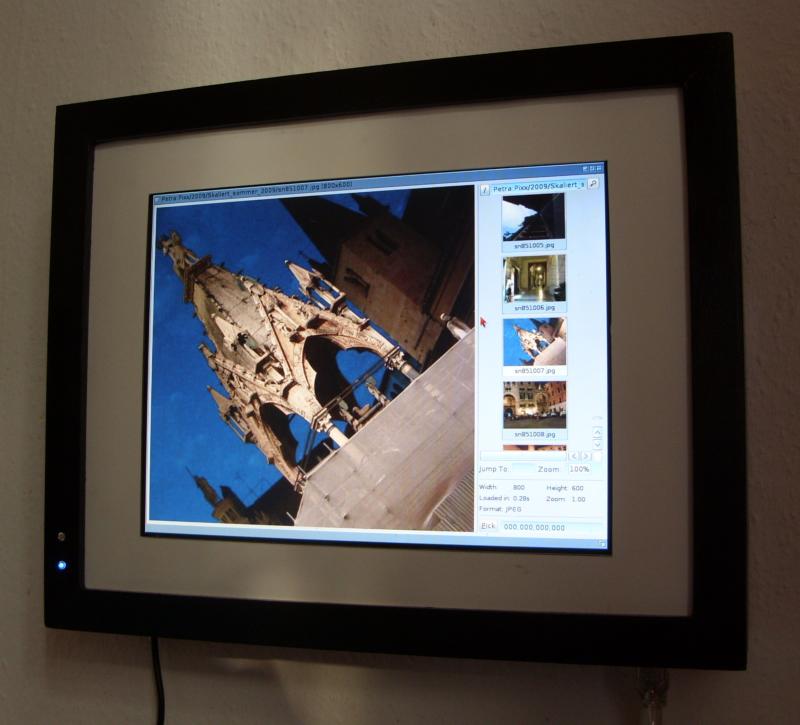
The internal changes included an upgrade of the gfx card to ATI 9250, a psu replacement and the internal cabling has been improved a lot. Externally the power cable is located on the left side now and closer to the wall. This lead to another overall look improvement of the external cabling - it is more balanced now.
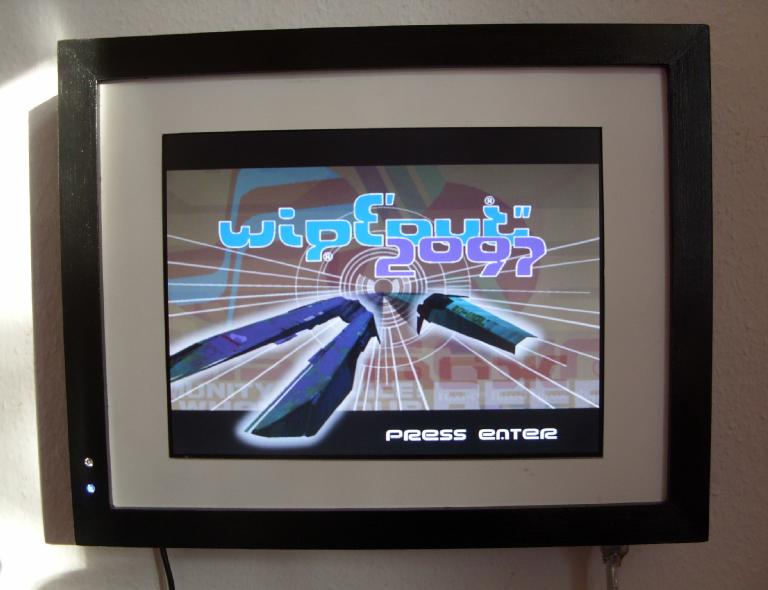
On the software side, the eframe runs MorphOS V2.3 now. It is pretty fast and reliable. The device works a s picture browser,
jukebox, video player, webterminal, game station and much more. The system keeps being snappy all the time.
I will add a specailly tailored software a bit later on, which easily provides access to basic functions, like slideshows,
movie aor music replay and basic information updates like weather forecasts and breaking news.

The LED crystals are still the design highlight and are looking pretty neat. Again the photos cannot provide the real impression

MorphOS on the eframe
New photos with some more content than the OpenFirmware console output only:
Displaying full screen photography of a romantic scenery (Do you know that place?1):
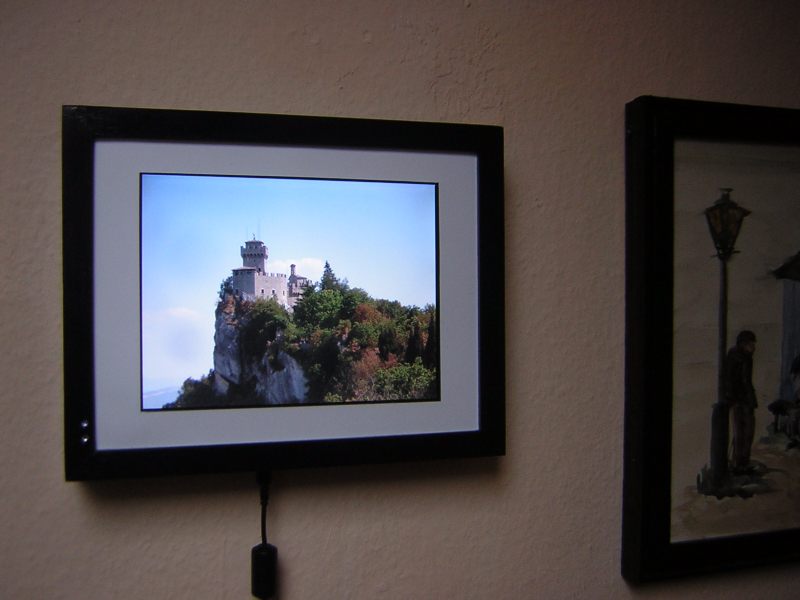
Picturebrowser ShowGirls showing some pictures:
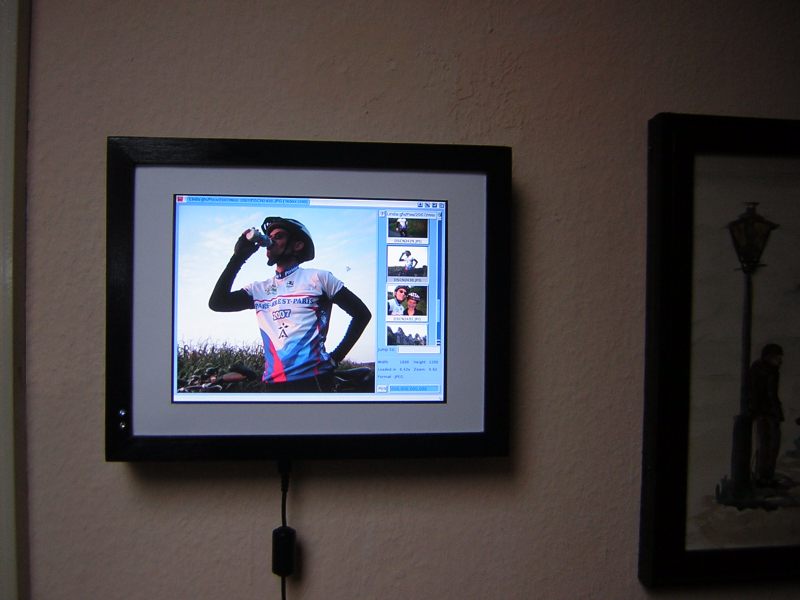
The frame as webterminal showing two internetpages2) :
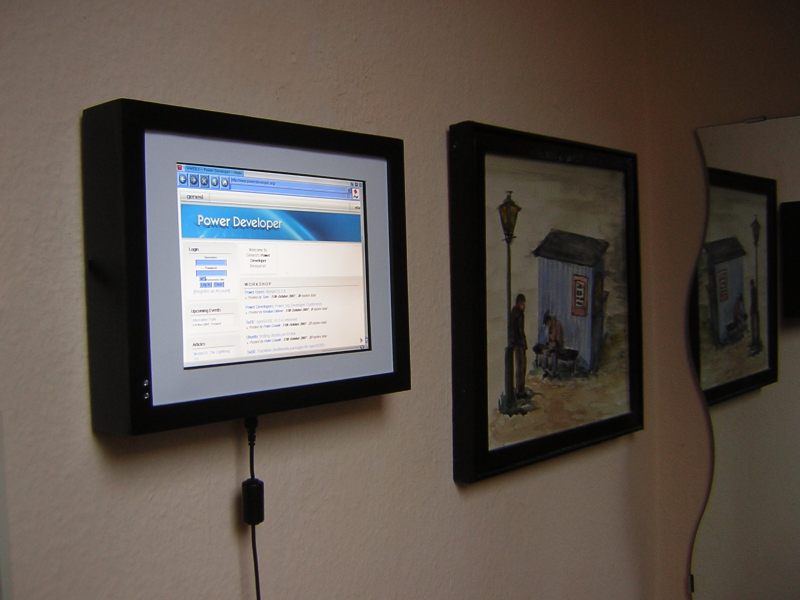
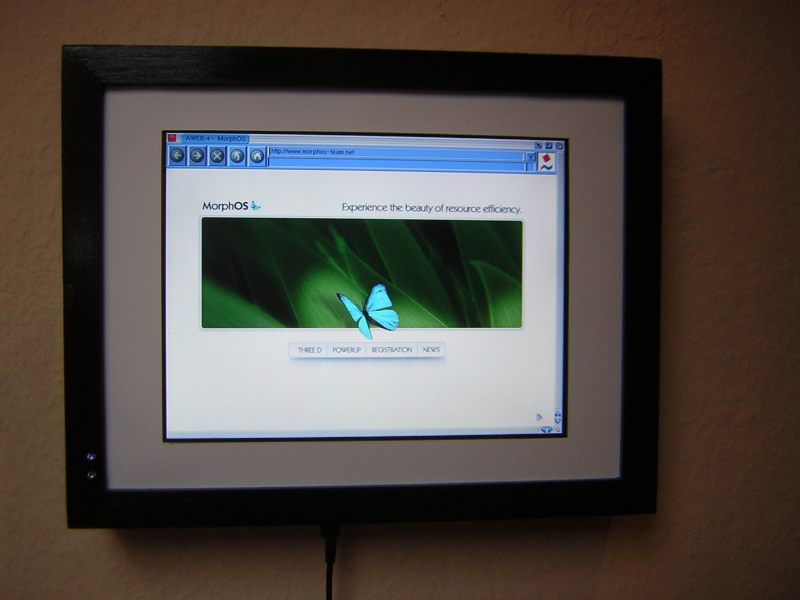
When taking these photos the illumination of the room was suboptimal, thus I will replace them with better quality ones later on.
--
1): The photo has been taken at the beautiful Repubblica di San Marino and shows one of the famous towers of Monte Titano
2): The two pages shown are: 1st powerdeveloper.org the community site by Genesi for Efika and Pegasos developers and 2nd morphos-team.net the official homepage for MorphOS.
1st report
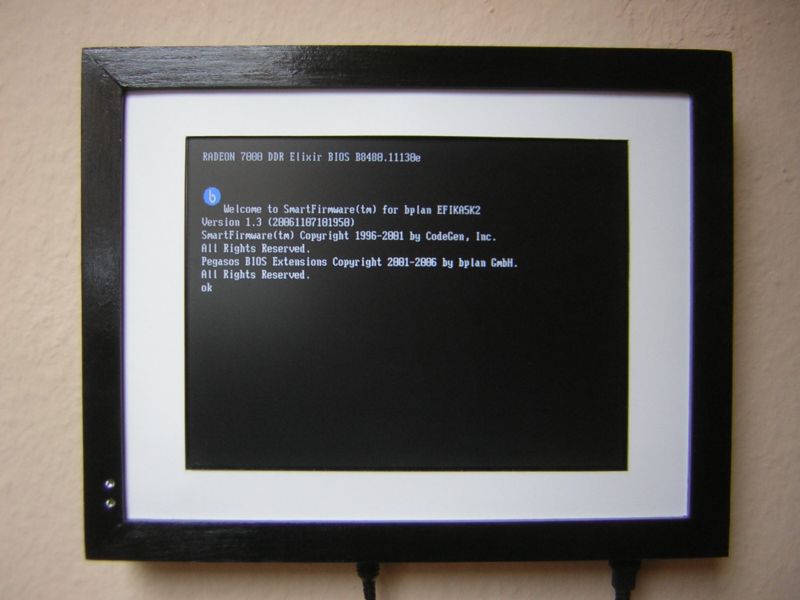
The display measures 10.3 inch in its diagonale and has a resolution of 800 x 600 pixels and uses a high quality
tft-panel by Sharp.
The 4:3 ratio follows the current most common picture format for digital cameras, thus most pictures need only a
rescaling, but no resizing, streching or shrinking of aspects. This helps to avoid black borders or badly cut pictures
The frame dimension is 31.5 x 24.5 x 6 cm.
The outer frame shell is wooden, the passepartout is a thick high quality aquarell paper.
Hanging on the wall it looks like that:
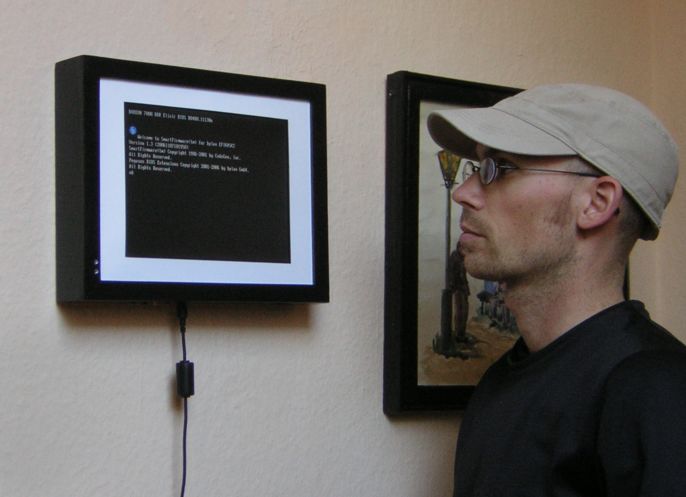
There are some details which should be mentioned. Operation is indicated with 2 ultrabright blue LEDs (power and harddisk activity) on the lower left part. These LEDs are covered by very shiny Swarovski; crystals as shown in the picture below.
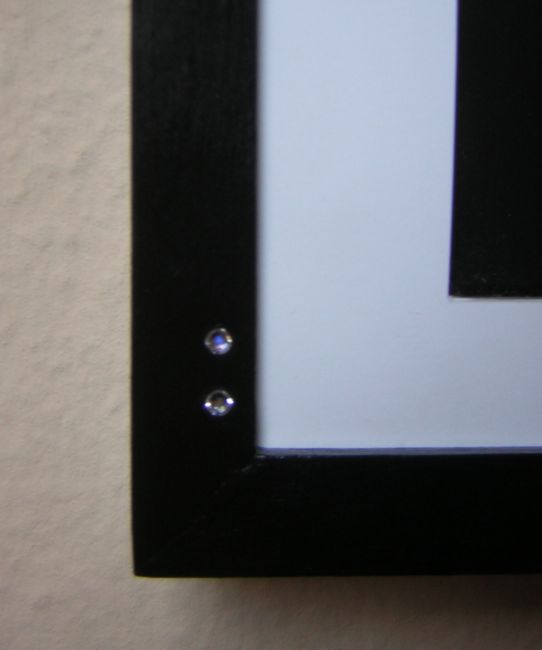
I have not yet a picture which shows these crystals very well.
They are shiny when the LED is off and blue glimmering when the LED is on.
On the bottom side there are some control switches and connectors.
- 12 VDC power in
- 2 x usb
- 10/100 Mb network
- audio in/out + S/PDIF
- 4 buttons for device control
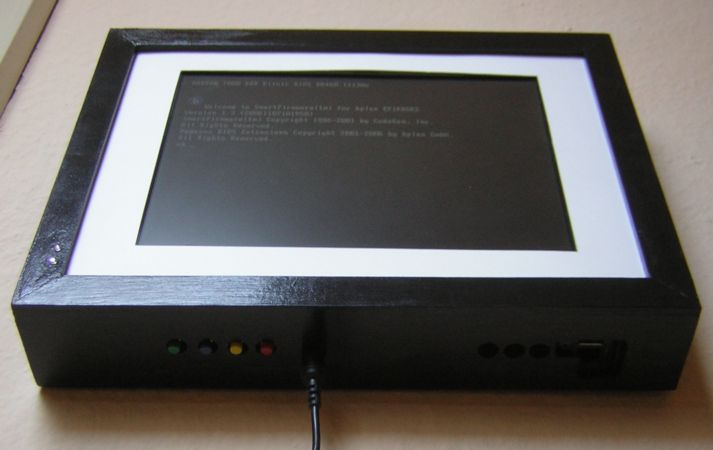
The four buttons control the following functions:
red: power on/off (atx)
yellow: reset
blue: display on/off
green: LED on/off
The display can be switched off seperately, as well as the power LED. The latter function may seem very little, but
the blue power LED may be a bit annoying when the frame is operating in dim lit or dark conditions and may
distract the focus from the display to the LED. Therefore it is possible to turn it off.
The display can also be turned off. Since this is a picture
frame this may seem strange on first sight, but this device is far more than just a picture
frame - it is more a multimedia device and low energy small home server (enough hdd space and
computing power and network).
For these home server functions or maybe when used as audio jukebox the display can be switched
off to save energy or for other reasons.
Inside the case there is the Efika mainboard with a 40GB 2.5" hdd and an ATI Radeon 7000 gfx card. Also a logic board by
Kontron has been added to connect the tft panel to the gfx card's vga output. The device gets 12 VDC power in and has an
ATX psu integrated which feeds the Efika as well as the Kontron board and the panel with its inverter logic.
Some simple circuits are added for LED operation and power off functions.
The original intention was to build a low cost frame, but as it turns out now a low cost
frame is not the way to go with the Efika. But a real multimedia frame with some home server capabilities is.
The device can act as picture frame, but also be a jukebox, a web terminal or serving data, be your webserver, whatever.
And it can do all this at the same time!
It hangs on the wall looking just like being a picture frame, but works hard in the background.
The classic design and virtually total silence (there are no fans inside) makes the device well suited for the living room.
The low energy uptake (and the possibility to reduce energy consume by switching off the display) are best conditions
for a 24/7 operation while maintaining high ecological standards.
The next prototype will be based on the Efika2 and will bring several enhancements, will be thinner, consume even less energy and use a different tft panel (the now used one is not RoHS compliant).
This first frame was more a proof of concept to get an idea about process and has its issues. The successor of this first one will become a "model 0" and may turn out into a commercial product.
On the software side I am currently still waiting for a copy of MorphOS for the Efika. Therefore these pictures show the OpenFirmware console output only.